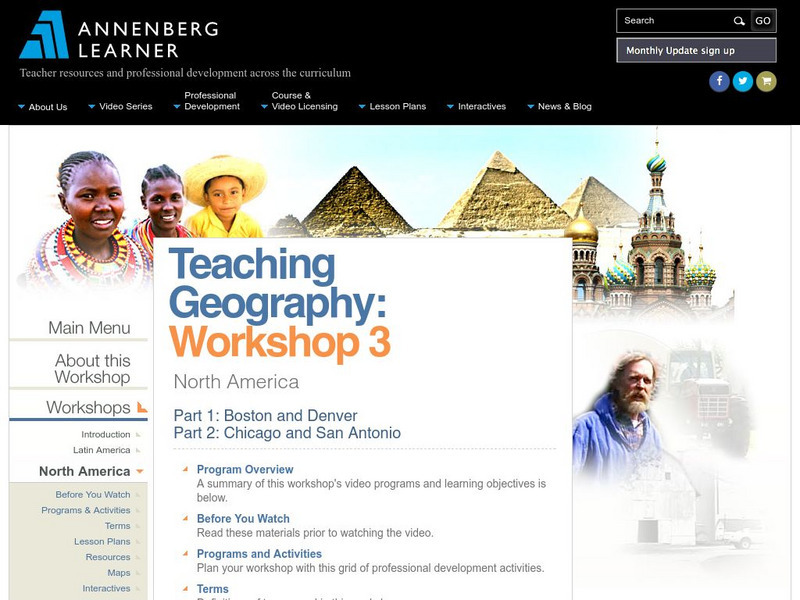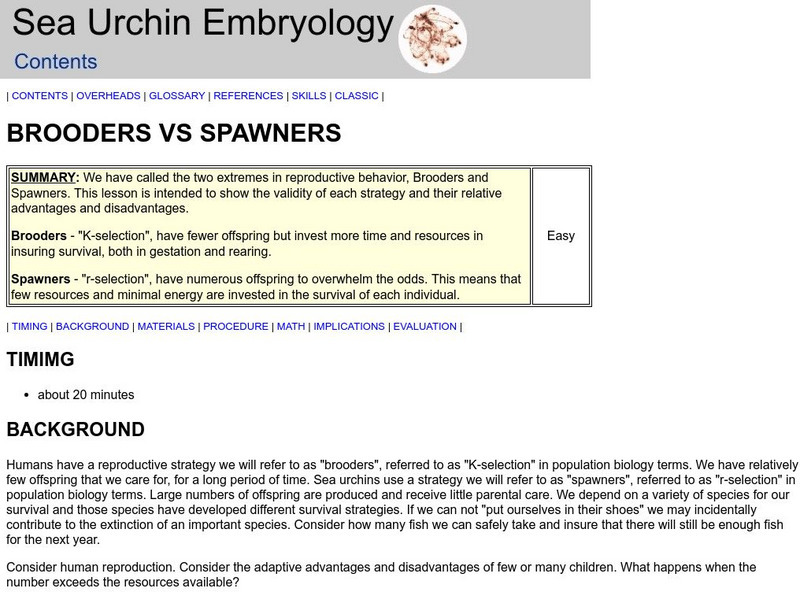Hi, what do you want to do?
American Psychological Association
Developing Adolescents
Why to young people act the way they do? Scholars investigate the stages of adolescent development incorporating high school psychology techniques. Using research from the American Psychological Association, they uncover the five areas...
College Board
AP® Psychology: Teaching Statistics and Research Methodology
Psychologists use statistics? Scholars investigate the research behind the methodology of statistical analysis. Using hands-on practice, case-studies, and scatterplots, they complete various tasks to understand the very roots of high...
Annenberg Foundation
Annenberg Learner: Teaching Geography: North America
Media-rich site that explores North America. The first part of this workshop focuses on the general human behavior in urban settings looking for and interpreting those patterns. The second portion draws attention to urban issues such as...
University of Illinois
University of Illinois: Illinois State Water Survey: Nitrogen Cycle: Human Impact on the Nitrogen Cycle
An overview of the impact of human activities on the environment and how those actions effect the nitrogen cycle.
Trinity University
Trinity University: Inherited Traits Versus Learned Behaviors [4Th Grade]
In this extremely detailed unit, learners will learn the about innate and learned characteristics in animals and humans through a series of teacher and student-led discussions, readings, reflections, learning activities, and...
Science Buddies
Science Buddies: Multitasking: Brain Drain or Boost in Efficiency?
Think it's a good idea to plug into iTunes, surf the Web, or watch TV while doing homework or trying to read? Many people do it and claim that jumping from one activity to another keeps their attention level up and even gives their brain...
Georgia Department of Education
Ga Virtual Learning: Sociology: Socialization
Sociology instructional unit on socialization. Students learn theories about human behavior and self development through audio, text, and instructional activities. Links to supplemental reading.
PBS
Idaho Public Television: Birds of Prey Facts
Dialogue for Kids, a program on Idaho Public Television, offers facts, information, and images of birds of prey. Learn what makes a bird a raptor, what raptors look like in the sky, threats that face these birds, and more! Classroom...
Georgia Department of Education
Ga Virtual Learning: Psychology: Biological Foundations
Virtual learning course on human biology and brain function and how it affects our behaviors. Extensive collection of engaging materials, assignments, and activities for review.
Stanford University
Stanford University: Brooders vs Spawners
A great explanation and hands-on activity to compare strategies of animal reproduction. Sea urchins and humans are compared.
Georgia Department of Education
Ga Virtual Learning: Psychology: Social Psychology
Complete and comprehensive Social Psychology learning module in which students learn about human social behavior through participation in interactive activities, videos, reading and writing assignments, review and assessment.
TeachEngineering
Teach Engineering: Surface Tension
Surface tension accounts for many of the interesting properties we associate with water. By learning about surface tension and adhesive forces, students learn why liquid jets of water break into droplets rather than staying in a...
Harvard University
Harvard University: Neurosurgical Service
This site from Harvard University offers a rating system of diagnosing Parkinson's Disease. It also presents the Unified Parkinson Disease Rating Scale (UPDRS) which measures mentation, behavior and mood, activities in daily life and...
Discovery Education
Discovery Education: Twins
This lesson encourages students to explore the phenomenon of identical twins, with emphasis on behavioral as well as genetic aspects. Teachers will appreciate extension activities, suggested readings, and links in addition to lesson plan...
Scholastic
Scholastic Explorers: Ocean Life
This lesson plan explores how human activity has an impact on turtles, sea otters, and dolphins in different parts of the world. Your young scholars will read field reports from the sites and evaluate data that is offered.
TeachEngineering
Teach Engineering: Next Generation Surgical Tools in the Body
Through this unit, students act as engineers who are given the challenge to design laparoscopic surgical tools. After learning about human anatomy and physiology of the abdominopelvic cavity, especially as it applies to laparoscopic...
Other
E Xpertise2 go.com: Introduction to Expert Systems
This tutorial shows you how a computer-based expert system emulates the behavior of a human advisor, presents terminology unique to the field, and introduces the activities that must be accomplished to build expert systems.


















